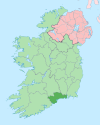|
Kilmacthomas
Kilmacthomas or Kilmactomas (Irish: Coill Mhic Thomáisín),[2] often referred to locally as "Kilmac",[3] is a town on the River Mahon in County Waterford, Ireland. It lies on the R677, a road north of the N25 national primary road from Dungarvan to Waterford. HistoryDuring the Cromwellian conquest of Ireland, in December 1649, Oliver Cromwell marched from Waterford to Kilmacthomas during the Siege of Waterford. The weather was wet and stormy and the river was in flood, so the army could not cross. Two nights were spent in the field that is now the public park. Cromwell was said to have described Waterford county on his march from Waterford to Kilmacthomas in the winter of 1649 as being a craggy and desolate place. After returning to Ireland after several years in Newfoundland, 18th-century Irish-language poet Donnchadh Ruadh Mac Conmara converted to Protestantism and joined the Church of Ireland parish at Rossmire, Newtown near Kilmacthomas. He was briefly appointed as parish clerk, but it is said that when the Vicar and parishioners discovered how great a rake he was, Donnchadh Ruadh was dismissed and converted back to Catholicism.[4] Daniel O'Connell passed through Kilmacthomas on a campaign trail and he wrote:[5]
In the early 1870s, the influence of the industrial revolution reached Kilmacthomas when the Waterford to Mallow railroad came to town. There is an example of a stone viaduct in the town spanning the Mahon River. Although the last passenger services ceased in the late 1960s the railway continued to operate with the haulage of oil and magnesite for another couple of decades. This railway is now disused. The viaduct at Kilmacthomas has been preserved and is part of the Waterford Greenway, which opened in 2017.[6][7] 
GeographyThe town has a population of 1,768. The chief tourist attractions of the locality are the Mahon Falls and Waterford Greenway. The village is situated on the River Mahon, the east bank is known as Kilmacthomas and the west bank as Gruaigeshuneen (Gráig Sheoinín). The postal area of Kilmacthomas can include Newtown (Baile Nua), Ballylaneen (Baile Uí Fhlaithnín), Lemybrien (Léim Uí Bhriain), Kill (An Chill), Mahon Bridge (Droichead na Machan), The Nire (Gleann na hUidhre), and Kilrossanty (Cill Rosanta). The N25 bridge over the River Mahon is named after local sporting hero Percy Kirwan. The Mahon River has a stock of wild brown trout. The salmon run mostly in the autumn and winter, but start running from the end of June. Salmon trout (know locally as "Pale") are also found in the river. Sea trout run in late July and August. There has been a collapse in fish stocks in the 1980s and 1990s[citation needed] but stocks are on the rise once more since a moratorium on netting has been emplaced. [citation needed] Geologically Kilmacthomas gives its name to the "Kilmacthomas Formation", which is composed of Palaeozoic deep marine metasediments and metavolcanics. Evidence of manganese nodules has been noted in the new bypass cutting recently constructed near the village. [citation needed] Kilmacthomas is located halfway between Waterford City and the county capital; Dungarvan. West of the village are the foothills of the Comeragh mountains, while five miles to the south is the 'Copper Coast' with the beach of Bonmahon / Bunmahon (Bun Machan). Economy
EducationThere are 4 schools in Kilmacthomas. St Declan's Community College is the largest second-level school in the county area, with in excess of 700 pupils. The (Kilmac') Convent Primary school caters for younger children, which is a mile away and has 100 students while the preschool boys and girls attend the Naíonra on the High Road. There are 16 different schools within 15 km of Kilmacthomas. Kilmacthomas Boys National School operated from 1966 until 2003 when it amalgamated with the Convent Primary School. Jack Giles served as the principal for over thirty years before the amalgamation. Sports clubsGaelic Athletic Association clubs in the area include:
People
See alsoReferences
|
||||||||||||||||||||||||||||||||||||||||||||||||||||||||||||||||||||||||||||||||||||||||


